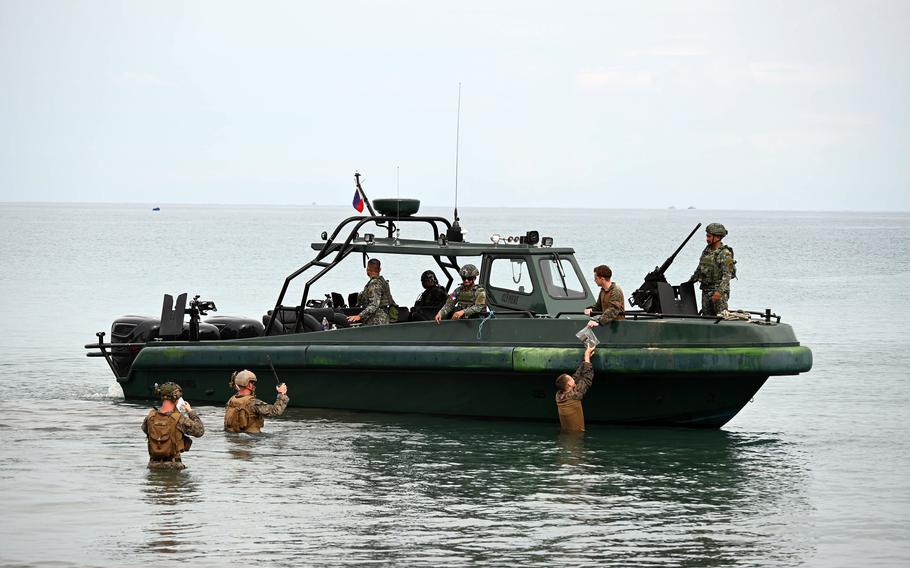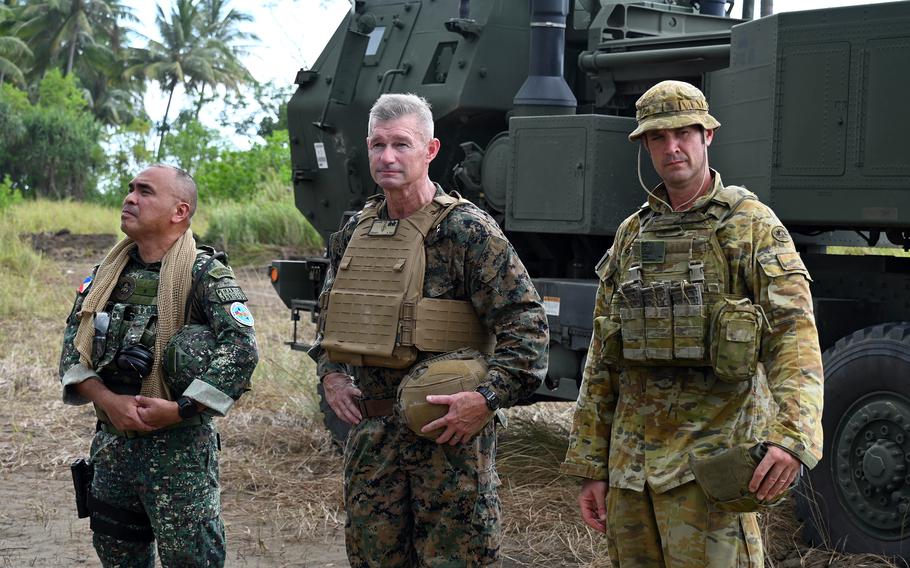
U.S. Marines wade to meet their comrades and Filipino counterparts in a small boat off the western coast of Palawan, Philippines, during a Balikatan drill on April 28, 2025. (Seth Robson/Stars and Stripes)
PALAWAN, Philippines — U.S., Filipino and Australian troops dug into beach dunes and unleashed a barrage of firepower — including high-powered rockets — during Balikatan training aimed this week at repelling an amphibious assault.
The beach-defense drill on Palawan, a narrow island along the Philippines’ western flank, featured live fire from machine guns, howitzers, precision missiles and the High Mobility Artillery Rocket System, or HIMARS, fired toward the South China Sea.
Balikatan — Tagalog for “shoulder to shoulder” — brings together about 9,000 American and 5,000 Filipino troops. Another 260 Australian service members joined, along with smaller contingents from Japan, the United Kingdom, France, Canada and others for 18 days of island-defense training, concluding May 9.
Monday’s drill opened with the Philippine navy firing a seaborne Spike ER precision tactical missile at a floating target, while Philippine artillery crews pounded other offshore targets with 105 mm howitzers. Meanwhile, troops in the dunes fired machine guns at targets floating closer to shore.
Members of 2nd Battalion, 1st Marine Regiment at Camp Pendleton, Calif., were among the beach defenders. They are part of the 2,500-strong Marine Rotational Force-Darwin, an annual, six-month mission in northern Australia. The Marines arrived on Palawan after training on Mindanao with Philippine forces earlier this month.
Australian soldiers emerged briefly from the dunes to sortie in a small inflatable boat, then fired a shoulder-mounted Javelin anti-tank missile toward the sea.
The drill ended with members of the U.S. Army’s 1st Multi-Domain Task Force, from Joint Base Lewis-McChord, Wash., firing six “ripper” shots from a HIMARS launcher set up near the beach. Rather than targeting ships, the rockets were aimed at pre-designated coordinates in the water, Capt. Johnny Fischer, a Marine spokesman, said by text message Tuesday.
While HIMARS is primarily designed for land-based targets, it can be adapted for anti-ship missions, Maj. Gen. Thomas Savage, commander of the 1st Marine Division, told reporters after the Palawan training.
“What you saw here today was simply long-range fires from a platform that normally fires from land to land,” he said.
The Navy-Marine Expeditionary Ship Interdiction System, or NMESIS — specifically designed to target ships — is also deployed for Balikatan. Members of the Hawaii-based 3rd Littoral Regiment are operating those launchers from northern Luzon and the Batanes Islands, the Philippines’ northernmost territory.
The Luzon Strait and Bashi Channel, which separate the northern Philippines from Taiwan, may figure prominently in a conflict over Taiwan between the U.S. and China. Beijing regularly deploys an aircraft carrier and its escorts through the channel and into waters off Taiwan’s eastern coast and sends military aircraft over the area.
NMESIS fires naval strike missiles with an approximate range of 115 miles, from mobile platforms that include 7-ton trucks and light tactical vehicles.
The Palawan training demonstrated the allies’ ability to combine land, sea and air forces with aircraft providing surveillance and small boats able to strike threats farther offshore, Savage said.
“The closer you get (to the coast) the more weapons systems you’re able to engage the targets with,” he said. “It takes work to synchronize the fires of three nations.”

Military leaders prepare to address the media after Balikatan live-fire training on the western coast of Palawan, Philippines, April 28, 2025. From left to right are Brig. Gen. Antonio Mangoroban, commander of the Philippines’ 3rd Marine Brigade; Maj. Gen. Thomas Savage, commander of the American 1st Marine Division; and Lt. Col. Hugh Grogan, head of the Australian army’s 5th Battalion. (Seth Robson/Stars and Stripes)
The training took place as tensions simmer in the South China Sea, where Philippine and Chinese coast guard vessels have clashed repeatedly.
Since mid-April, both countries have posted photos of their service members, holding their national flags on Sandy Cay.
The three small sandbars in the Spratly Islands lie between Thitu Island, occupied by the Philippines, and Subi Reef, where China has built a military-grade runway and buildings with communications facilities.
However, Brig. Gen. Jimmy Larida Mangoroban, commander of the Philippines’ 3rd Marine Brigade, told reporters the training was unrelated to those disputes.
“We have been doing this for 40 years now,” he said of Balikatan. “There [was] no issue with China 40 years ago.”